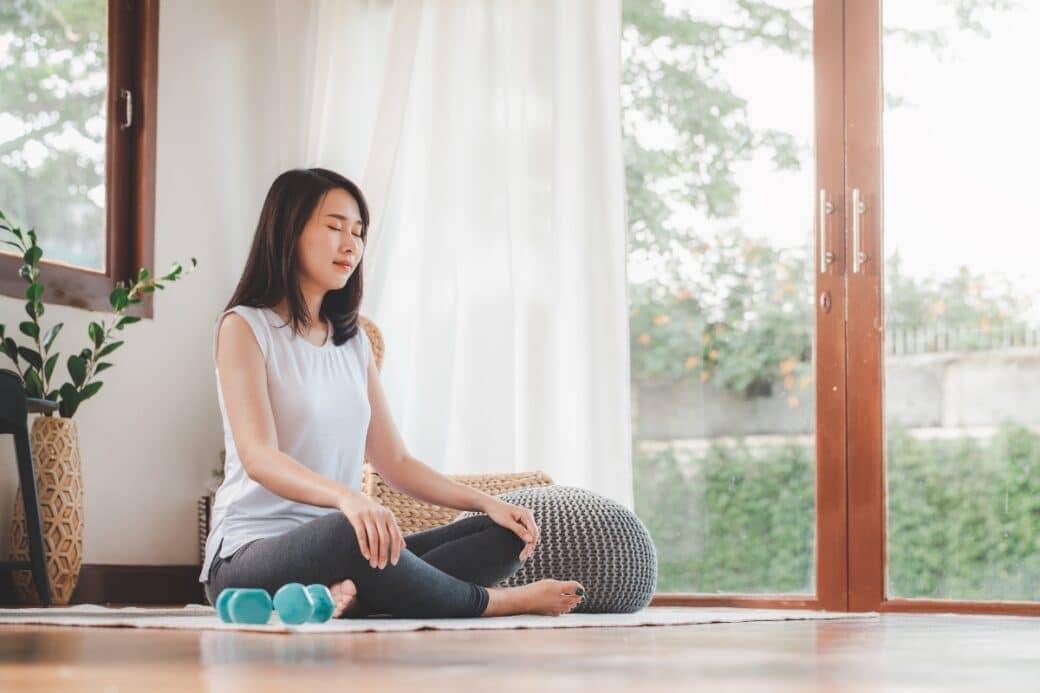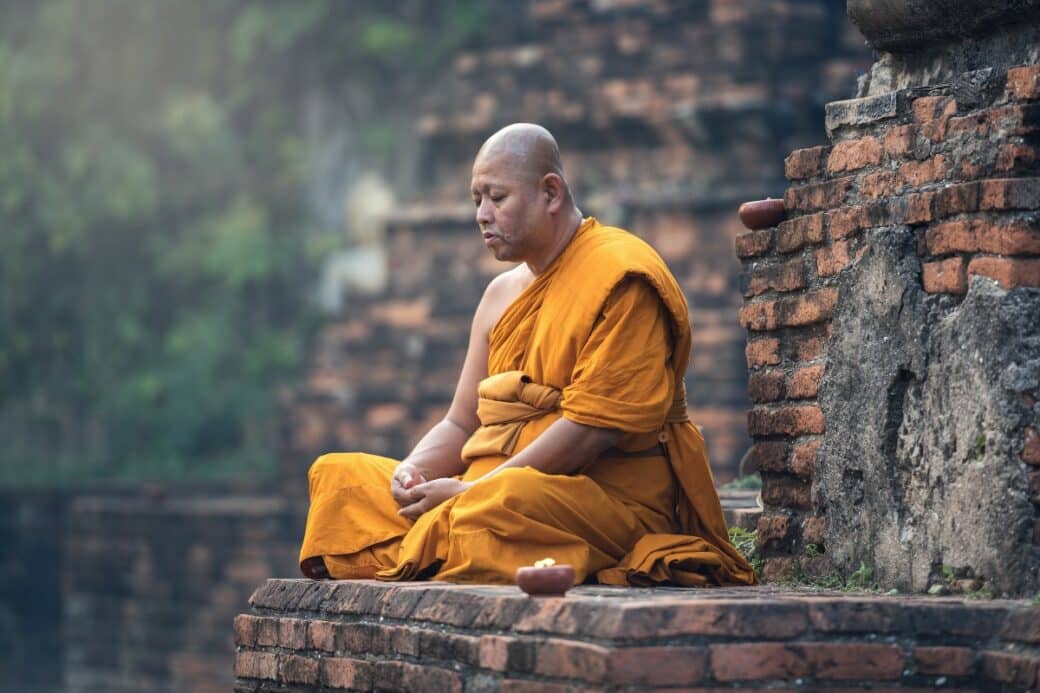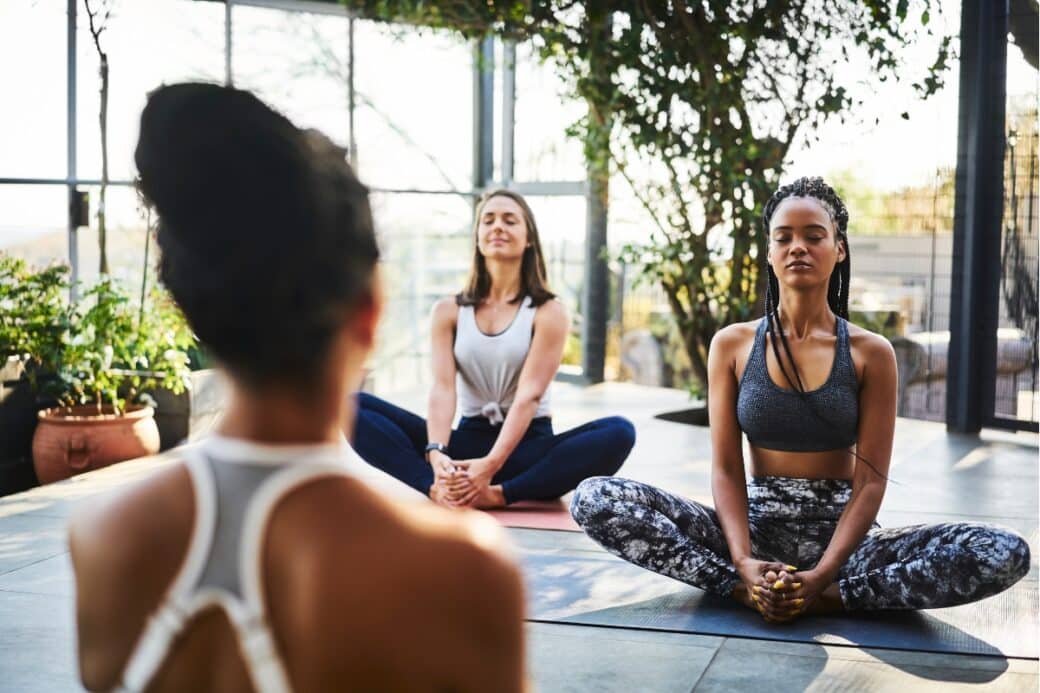Want to start meditating but not sure where to begin? Look no further! This article will provide you with simple techniques that will make meditation easy, even for beginners. Whether you’re seeking stress relief or simply want to improve your focus and well-being, these tips will help you on your journey to finding inner peace and tranquility. So take a deep breath, relax, and let’s get started on your meditation journey!

Understanding Meditation
What is meditation?
Meditation is a practice that allows you to train your mind and bring a sense of calm and clarity into your life. It involves focusing your attention and eliminating the stream of thoughts that often occupy your mind. By engaging in meditation, you can cultivate a state of present moment awareness and cultivate a deep sense of peace and relaxation.
Different types of meditation
There are various types of meditation that you can choose from, depending on your personal preferences and goals. Some common types include:
-
Mindfulness Meditation: This involves focusing your attention on your present moment experience, including your thoughts, feelings, and bodily sensations.
-
Mantra Meditation: In this type of meditation, you repeat a specific word or phrase (mantra) to help focus your mind and enter a state of deep relaxation.
-
Visualization Meditation: Here, you create vivid mental images to promote relaxation and achieve specific goals.
-
Breathing Meditation: This type of meditation emphasizes paying attention to your breath as the primary point of focus.
Benefits of meditation
Meditation offers numerous benefits for both your mental and physical well-being. Some of the key advantages of regular meditation practice include:
-
Stress reduction: Meditation helps calm the mind and relax the body, reducing the negative effects of stress on your overall health.
-
Improved focus and concentration: By training your mind to stay present and focused, meditation enhances your ability to concentrate and stay attentive.
-
Enhanced emotional well-being: Regular meditation practice promotes a positive mindset, emotional resilience, and a greater sense of happiness.
-
Better sleep: Meditation can help alleviate insomnia and create a conducive environment for restful and rejuvenating sleep.
-
Physical health benefits: Studies have shown that meditation can lower blood pressure, improve immune function, and reduce chronic pain.
Common misconceptions about meditation
Despite its widespread popularity, there are still some common misconceptions surrounding meditation. Here are a few of the most prevalent ones:
-
You need to completely clear your mind: Many beginners assume that meditation requires clearing the mind of all thoughts. However, the goal is not to stop thinking entirely but to observe your thoughts without attachment or judgment.
-
Meditation is only for religious or spiritual people: While meditation has roots in various spiritual traditions, it is a practice that can be beneficial for anyone, regardless of their beliefs or background.
-
Meditation is time-consuming: Contrary to belief, you can start with just a few minutes of meditation each day and gradually increase the duration as you become more comfortable with the practice.
-
You must sit cross-legged to meditate: While the cross-legged posture is commonly associated with meditation, it is not a requirement. You can meditate in any comfortable position that allows you to stay relaxed and alert.
Getting Started With Meditation
Creating a calm and comfortable space for meditation
To establish a peaceful environment for your meditation practice, find a quiet and clutter-free space in your home. It could be a spare room, a corner of your bedroom, or even a peaceful spot in your garden. Decorate the space with elements that promote relaxation, such as cushions, candles, or plants. Ensure that the lighting is soft and gentle, and eliminate any distractions like electronic devices or noisy appliances.
Choosing the best time for meditation
Selecting the optimal time to meditate is crucial for establishing a consistent practice. It’s recommended to choose a time when you are least likely to be interrupted or distracted. For some, meditating early in the morning before the day begins can be beneficial, as the mind is often less cluttered. Others may find that meditating in the evening helps them unwind and prepare for a restful night’s sleep. Ultimately, choose a time that works best for you and your schedule.
Determining the length of meditation sessions
When starting with meditation, it’s important not to overwhelm yourself. Begin with shorter sessions, such as 5 or 10 minutes, and slowly increase the duration as you become more comfortable. Give yourself permission to start small and gradually build up to longer meditation sessions. Remember, consistency is key, so it’s better to meditate for a shorter period regularly than to engage in longer sessions infrequently.
Setting a meditation goal
Setting a meditation goal can help provide direction and motivation in your practice. Think about why you want to meditate and what you hope to gain from it. Your goal could be anything from reducing stress and improving focus to cultivating self-compassion or increasing mindfulness in daily life. Write down your goal and keep it in mind as you embark on your meditation journey. Having a clear intention can help you stay committed and focused.
Breathing Techniques for Meditation
Understanding the role of breathing in meditation
In meditation, breathing serves as an anchor for your attention, helping you stay present and focused. Paying attention to your breath allows you to tune into your body’s natural rhythms and become aware of the present moment. By observing the breath without trying to control it, you can cultivate a sense of calm and relaxation.
Practice deep breathing
Deep breathing is a simple yet effective technique for calming the mind and relaxing the body. Sit comfortably in a quiet space, close your eyes, and take a deep breath in through your nose, allowing your belly to expand. Slowly exhale through your mouth, feeling a sense of release and letting go of any tension. Repeat this deep breathing pattern for a few minutes, focusing your attention solely on your breath.
Breath awareness technique
The breath awareness technique involves observing your breath without attempting to change it. Find a comfortable position, either sitting or lying down, and bring your attention to the sensation of your breath as it enters and leaves your body. Notice the rise and fall of your abdomen or the feeling of air passing through your nostrils. Whenever your mind wanders, gently bring your focus back to the breath.
4-7-8 breathing technique
The 4-7-8 breathing technique is a simple yet powerful breathing exercise for relaxation. Begin by placing the tip of your tongue against the roof of your mouth, right behind your teeth. Breathe in silently through your nose to a mental count of 4. Hold your breath for a count of 7. Exhale forcefully through your mouth to a count of 8, making a whooshing sound. Repeat this cycle four times, and you’ll feel a deep sense of calm and tranquility.
Body Awareness Techniques for Meditation
Using body scan technique for relaxation
The body scan technique involves systematically moving your attention through different parts of your body, from head to toe, to cultivate a sense of relaxation and awareness. Find a comfortable position, either lying down or sitting, and bring your attention to your body. Begin by focusing on your toes, noticing any sensations or tension. Slowly move your attention up through your feet, legs, torso, arms, and head, observing any sensations you encounter along the way.
Mindful movement
Mindful movement is a form of meditation that involves combining the practice of meditation with gentle physical movements. It could be as simple as walking mindfully in nature, practicing yoga, or engaging in tai chi. The key is to bring your attention to the physical sensations and movements of your body, cultivating a deep sense of presence and awareness.
Progressive muscle relaxation
Progressive muscle relaxation is a technique that involves tensing and releasing different muscle groups to promote relaxation and relieve physical tension. Start by sitting or lying down in a comfortable position. Begin with your feet, tightly squeezing the muscles, and then release. Move up to your calves, thighs, abdomen, chest, arms, and finally, your face. Take your time to tense and release each muscle group, paying attention to the sensations as you let go of tension.
Grounding techniques
Grounding techniques help bring your attention to the present moment and create a sense of stability. One simple grounding technique involves focusing on the sensation of your feet on the ground. Whether you are standing, sitting, or lying down, direct your attention to the feeling of your feet making contact with the surface beneath you. Notice the pressure, temperature, and texture. This technique can help calm a racing mind and foster a sense of stability and rootedness.
Using Mantras in Meditation
Understanding what a mantra is
A mantra is a word, phrase, or sound that is repeated during meditation to help focus the mind and enter a state of deep relaxation. The repetition of a mantra helps quiet the internal chatter and cultivate a sense of tranquility and inner peace.
Choosing a personal mantra
When selecting a mantra, it’s essential to choose one that resonates with you personally and aligns with your intentions or goals for meditation. It could be a positive affirmation, a meaningful phrase, or a sacred word from a spiritual tradition. Experiment with different mantras and see which one draws you in and helps you feel more centered and focused.
How to use a mantra in meditation
To use a mantra in meditation, find a comfortable position and begin repeating the chosen mantra either silently or aloud. Allow the sound and vibration of the mantra to fill your awareness, gently pushing aside other thoughts. Return to the mantra whenever your mind starts to wander. By continuously repeating the mantra, you can attune your mind to a more peaceful and focused state.
Visualization Techniques in Meditation
What is visualization meditation?
Visualization meditation is a technique that involves creating vivid mental images to promote relaxation, focus, and the manifestation of specific goals. By engaging your imagination, you can tap into the power of your mind to create positive changes in your life.
Creating a visual image
To practice visualization meditation, find a quiet space and settle into a comfortable position. Close your eyes and begin by visualizing a peaceful scene, such as a beautiful beach or a serene forest. Engage all your senses to make the image as vivid and detailed as possible. Notice the colors, sounds, smells, and textures. Immerse yourself in the experience and allow yourself to feel a deep sense of tranquility and relaxation.
Using guided visualization
If you find it challenging to create visualizations on your own, you can use guided visualization techniques. Guided visualizations involve listening to a recorded meditation or following along with a script that guides your imagination through various scenes and scenarios. These guided practices can be particularly helpful for beginners and those who prefer extra guidance in their meditation practice.
Mindfulness Meditation Techniques
Understanding the concept of mindfulness
Mindfulness is the practice of intentionally paying attention to the present moment without judgment. It involves observing your thoughts, emotions, and sensations with an attitude of curiosity and acceptance. Mindfulness meditation helps cultivate a deeper sense of self-awareness and allows you to fully engage with each moment as it unfolds.
Mindful breathing
Mindful breathing is a fundamental practice in mindfulness meditation. Sit comfortably in a quiet space and focus your attention on your breath. Notice the sensation of the breath as it enters and leaves your body. If your mind wanders, gently bring your focus back to the breath, without judgment. By anchoring your awareness in the present moment, you can cultivate a deep sense of calm and presence.
Mindful observation
In mindful observation, you practice bringing your attention to your immediate environment and observing it without judgment. Choose an object or a scene in front of you and allow your attention to rest on it. Notice the colors, shapes, textures, and any other details that come into your awareness. Allow yourself to observe without analyzing or labeling. This practice helps cultivate a sense of non-reactivity and openness to the present moment.
Practicing mindfulness in daily tasks
Bringing mindfulness into your daily activities is a powerful way to integrate meditation into your life. Choose a routine activity, such as washing dishes, brushing your teeth, or taking a shower, and engage fully in the experience. Notice the sensations, smells, sounds, and movements associated with the task. If your mind wanders, gently bring your attention back to the present moment. By practicing mindfulness in your daily tasks, you can transform mundane activities into opportunities for self-awareness and relaxation.
Overcoming Challenges in Meditation
Dealing with a wandering mind
A wandering mind is a common challenge in meditation, and it’s important to remember that it’s a natural part of the process. When you notice your mind wandering, gently bring your attention back to your chosen point of focus, whether it’s your breath, a mantra, or a visual image. Be patient with yourself and remember that meditation is a practice of training the mind, and it takes time and consistency to strengthen your ability to stay present.
Handling physical discomfort during meditation
Physical discomfort, such as stiffness or pain, can be a distraction during meditation. To address this, ensure that you are in a comfortable position and adjust your posture as needed. Experiment with different meditation props, such as cushions or blankets, to support your body. If discomfort persists, try incorporating gentle stretches or yoga poses before your meditation practice to release tension and promote relaxation.
Overcoming sleepiness during meditation
Feeling sleepy during meditation is natural, especially if you are practicing in the evening or when you are tired. To combat sleepiness, try meditating in an upright position rather than lying down. Open your eyes slightly or focus your gaze on a specific point to stay alert. You can also experiment with engaging in a brief physical activity, such as stretching or taking a short walk, before meditating to increase your energy level.
Staying consistent with meditation practice
Consistency is key when it comes to reaping the benefits of meditation. Establishing a regular meditation routine can be challenging, but it’s crucial for progress and growth. Set realistic goals for yourself and find a time and place that work best for your schedule. Consider joining a meditation group or finding an accountability partner to stay motivated and committed to your practice. Remember that even a few minutes of meditation each day is better than none, and every moment of mindfulness counts toward your progress.
Leveraging Technology for Meditation
Best meditation apps
In today’s digital age, there are numerous meditation apps available that can support and enhance your meditation practice. Some popular meditation apps include Headspace, Calm, Insight Timer, and 10% Happier. These apps offer a variety of guided meditations, timers, and other features to help you cultivate mindfulness and relaxation.
Using online guided meditations
Online guided meditations are a convenient and accessible resource for beginners and experienced meditators alike. Many meditation teachers and organizations offer free or paid guided meditation recordings on their websites or YouTube channels. These guided meditations can provide structure and support as you deepen your practice and explore different techniques.
Meditation music and sounds
Listening to calming music or nature sounds can enhance your meditation experience and create a soothing atmosphere. Experiment with different genres of music, such as classical, ambient, or instrumental, to find the type that resonates with you. Alternatively, you can explore nature sounds like ocean waves, rain showers, or bird songs to bring a sense of tranquility and serenity to your meditation space.
Advanced Meditation Techniques for Beginners
Deepening your meditation practice
Once you have established a foundation in meditation, you can explore advanced techniques to deepen your practice. This could involve longer meditation sessions, more challenging breathing exercises, or incorporating additional elements such as chanting or mudras. It’s essential to approach advanced techniques with patience and respect for your own limitations, gradually incorporating them into your practice over time.
Exploring meditative walking
Meditative walking, also known as walking meditation, is a form of meditation that involves bringing your attention to the physical sensations and movements of walking. Find a quiet and peaceful place outdoors and start walking at a slow and deliberate pace. Focus on the sensation of your feet touching the ground, the rhythm of your steps, and the flow of your breath. Engaging in meditative walking can help you cultivate mindfulness while enjoying the benefits of physical activity and connection with nature.
Experimenting with advanced breathing techniques
As you progress in your meditation practice, you can explore more advanced breathing techniques to deepen your relaxation and enhance your focus. Techniques such as alternate nostril breathing, bellows breath, or breath retention can bring a new dimension to your meditation experience. Ensure that you learn these techniques from a qualified instructor or reputable source to practice them safely and effectively.
Advanced visualization methods
Advanced visualization methods can take your meditation practice to the next level by incorporating more complex visualizations or incorporating symbolic imagery. You can visualize yourself achieving specific goals, manifesting abundance, or connecting with your higher self. These advanced visualization techniques can be powerful tools for personal growth, self-discovery, and spiritual development.
As you embark on your meditation journey, remember to approach it with a sense of curiosity, openness, and compassion for yourself. Meditation is a deeply personal practice, and it may take time to find the techniques that resonate with you. Enjoy the process, stay consistent, and celebrate the transformative effects of meditation on your mind, body, and spirit.




